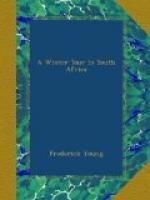I attended two or three debates in the House of Parliament, and was much impressed with the manner in which, in this superb and commodious legislative chamber, the discussions were carried on. There was a quiet dignity of debate, as well as business-like capacity and orderly tone, observed on both sides of the House, which might be copied with advantage, as it is in striking contrast to much of the practice, in the Parliament of Great Britain. It is certainly satisfactory to notice, that the modern manners and customs, in the popular branch of our own ancient national assembly, which so frequently fail in orthodox propriety, have not been imitated in the Cape Colony.
At the Record Office attached to the House of Parliament, I went into the vaults, and inspected the early manuscripts of the Dutch, during their original occupation of the Cape of Good Hope. These are most deeply and historically interesting, and valuable. The minute accuracy, with which every incident is recorded is most remarkable. There are bays in these vaults, filled with records, which must be of priceless value to an historical student, and they are now in course of arrangement by the able librarian, Mr. H.C.V. Leibbrandt, who is the author of a most interesting work entitled “Rambles through the Archives of the Colony of the Cape of Good Hope."[A]
At the South African Museum I found a valuable collection of beasts, birds, fishes, &c., not only from South Africa, but from various parts of the world. The collection has been enriched by valuable contributions from Mr. Selous, the distinguished African traveller, and sportsman, his donations consisting chiefly of big game, including two gigantic elands, (male and female), buffaloes, antelopes, &c. The series of birds comprises the large number of two thousand species.
A visit of great interest to me was to the South African Public Library, which boasts of about 50,000 volumes, and embraces every branch of science and literature. It contains three distinct collections, viz., the Dessinian, the Grey, and the Porter. The first-named was bequeathed to the Colony in 1761 by Mr. Joachim Nicholas Von Dessin, and consists of books, manuscripts and paintings. The Porter collection took its name from the Hon. William Porter, and was purchased from the subscriptions raised for the purpose of procuring a life-size portrait of that gentleman, in recognition of his services to the Colony. As, however, Mr. Porter declined to sit for his portrait, the amount subscribed was appropriated to the purchase of standard works, to be known as the Porter Collection. By far the most valuable, however, is the Grey Collection, numbering about 5,000 volumes, and occupying a separate room. These were presented by Sir George Grey, Governor of the Cape Colony from 1854 to 1859, and still an active member of the New Zealand House of Representatives. Here are many rare manuscripts, mostly on vellum or parchment, some of them of the tenth century, in addition to a unique collection of works relating to South Africa generally.




